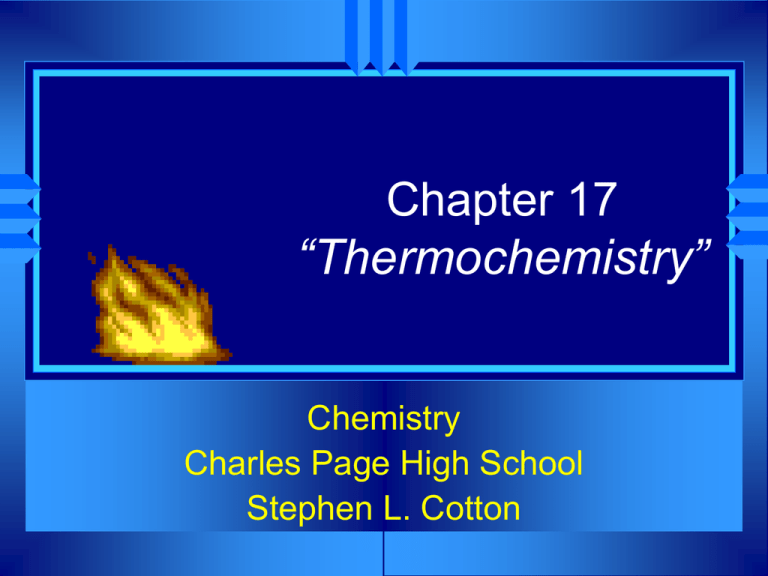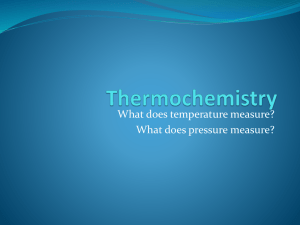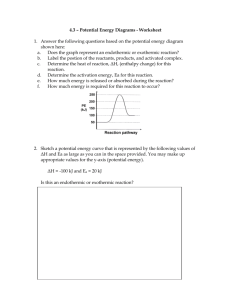Thermochemistry notes
advertisement

Chapter 17 “Thermochemistry” Chemistry Charles Page High School Stephen L. Cotton Energy Transformations “Thermochemistry” - concerned with heat changes that occur during chemical reactions Energy - capacity for doing work or supplying heat • weightless, odorless, tasteless • if within the chemical substancescalled chemical potential energy 2 Energy Transformations Gasoline contains a significant amount of chemical potential energy Heat - represented by “q”, is energy that transfers from one object to another, because of a temperature difference between them. • only changes can be detected! • flows from warmer cooler object 3 Conduction – heat transferred by particles colliding into one another, such as in a metal. Transfer of energy by touch Not an effective transfer in a gas. Primarily solids Conduction Convection Convection – heat transferred by the circulation of a fluid (or gas), such as in a heating system at home; important near the surface of the Sun. Hot air rises cool air falls Radiation Radiation – heat transferred by the flow of electromagnetic radiation, like heat felt from the campfire. Radiation is the only type of heat transfer that can happen in a vacuum. Heat transfer through waves Exothermic and Endothermic Processes Essentially all chemical reactions and changes in physical state involve either: a) release of heat, or b) absorption of heat Exothermic and Endothermic Processes In studying heat changes, think of defining these two parts: • the system - the part of the universe on which you focus your attention • the surroundings - includes everything else in the universe Exothermic and Endothermic Processes Together, the system and it’s surroundings constitute the universe Thermochemistry is concerned with the flow of heat from the system to it’s surroundings, and vice-versa. Exothermic and Endothermic Processes The Law of Conservation of Energy states that in any chemical or physical process, energy is neither created nor destroyed. • All the energy is accounted for as work, stored energy, or heat. Exothermic and Endothermic Processes flowing into a system from it’s surroundings: • defined as positive • q has a positive value • called endothermic –system gains heat (gets warmer) as the surroundings cool down Heat Exothermic and Endothermic Processes Heat flowing out of a system into it’s surroundings: • defined as negative • q has a negative value • called exothermic –system loses heat (gets cooler) as the surroundings heat up Exothermic and Endothermic Every reaction has an energy change associated with it Exothermic reactions release energy, usually in the form of heat. Endothermic reactions absorb energy Energy is stored in bonds between atoms 13 Endothermic and Exothermic ∆H>0 ∆H<0 Units for Measuring Heat Flow 1) A calorie is defined as the quantity of heat needed to raise the temperature of 1 g of pure water 1 oC. • • • Used except when referring to food a Calorie, (written with a capital C), always refers to the energy in food 1 Calorie = 1 kilocalorie = 1000 cal. 15 Units for Measuring Heat Flow 2) The calorie is also related to the Joule, the SI unit of heat and energy • named after James Prescott Joule • 4.184 J = 1 cal Heat Capacity - the amount of heat needed to increase the temperature of an object exactly 1 oC • Depends on both the object’s mass and its chemical composition 16 Heat Capacity and Specific Heat Specific Heat Capacity (abbreviated “C”) - the amount of heat it takes to raise the temperature of 1 gram of the substance by 1 oC • often called simply “Specific Heat” • Note Table 17.1, page 508 (next slide) has a HUGE value, when it is compared to other chemicals Water 17 Note the Table of Specific Heats tremendous difference in Specific Heat. Water’s value is VERY HIGH. Heat Capacity and Specific Heat water, C = 4.18 J/(g oC) in Joules, and C = 1.00 cal/(g oC) in calories. Thus, for water: • it takes a long time to heat up, and • it takes a long time to cool off! Water is used as a coolant! • Note Figure 17.4, page 509 For 19 Heat Capacity and Specific Heat To calculate, use the formula: q = mass (in grams) x T x C heat is abbreviated as “q” T = change in temperature C = Specific Heat • Units are either: J/(g oC) or cal/(g oC) 20 - Page 510 Calorimetry Calorimetry - the measurement of the heat into or out of a system for chemical and physical processes. • Based on the fact that the heat released = the heat absorbed The device used to measure the absorption or release of heat in chemical or physical processes is called a “Calorimeter” Calorimetry Foam cups are excellent heat insulators, and are commonly used as simple calorimeters under constant pressure. (They are good because they are well-insulated.) For systems at constant pressure, the “heat content” is the same as a property called Enthalpy (H) of the system A foam cup calorimeter – here, two cups are nestled together for better insulation Calorimetry in enthalpy = H q = H These terms will be used interchangeably in this textbook Thus, q = H = m x C x T H is negative for an exothermic reaction H is positive for an endothermic reaction Changes







